Abstract
An enzyme-linked immunosorbent plaque assay is described which can reliably enumerate influenza virus-specific antibody-secreting cells and exhibits specificity similar to that of the indirect enzyme-linked immunosorbent assay. The assay was used to characterize the development of specific antibody-secreting cells, principally within lung tissue, during primary murine influenza virus infection after intranasal inoculation. Cells secreting influenza virus-specific immunoglobulin M (IgM), IgG, and IgA were detected in greatest numbers in lung tissue, and the data presented indicated that the cells may have originated from specific B-cell precursors in lung tissue which are demonstratable in vitro. At 11 months after infection, cells secreting IgG and IgA were still present in lung tissue. Influenza virus-specific antibody-secreting cells were also detected in spleen tissue and blood. Antibody-secreting cells appeared earlier in spleen than in lung tissue and declined more rapidly in spleen tissue.
Full text
PDF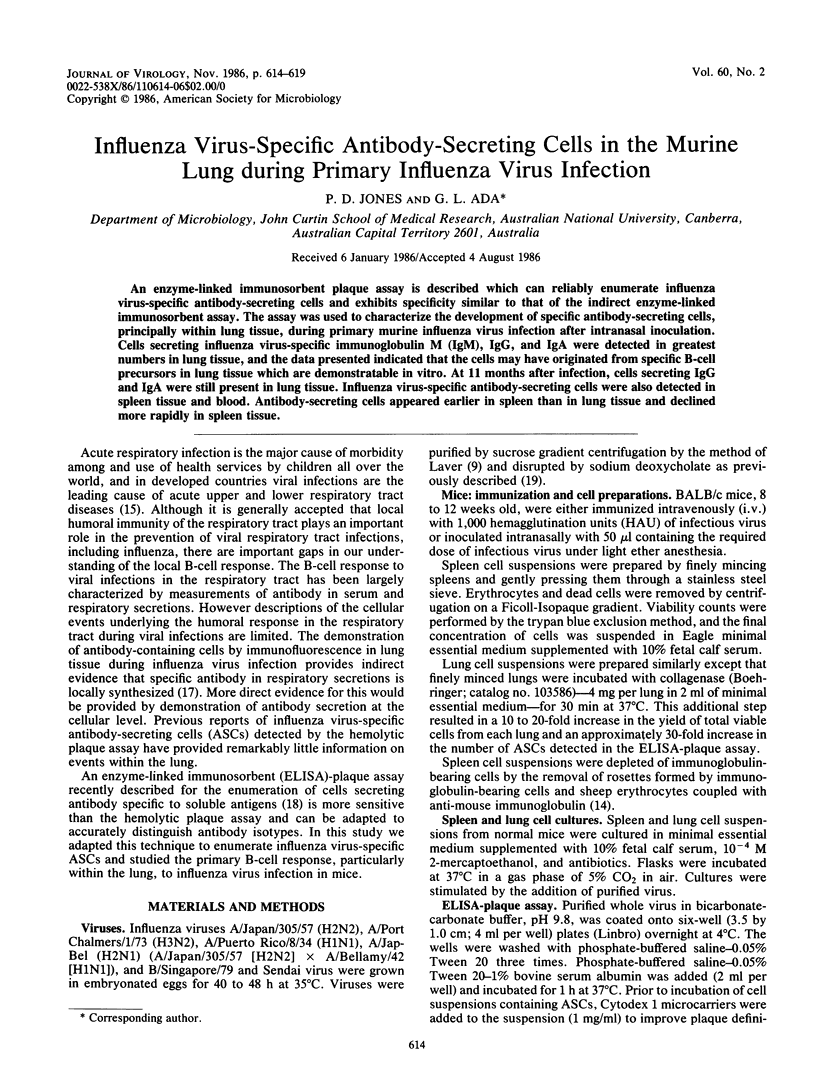
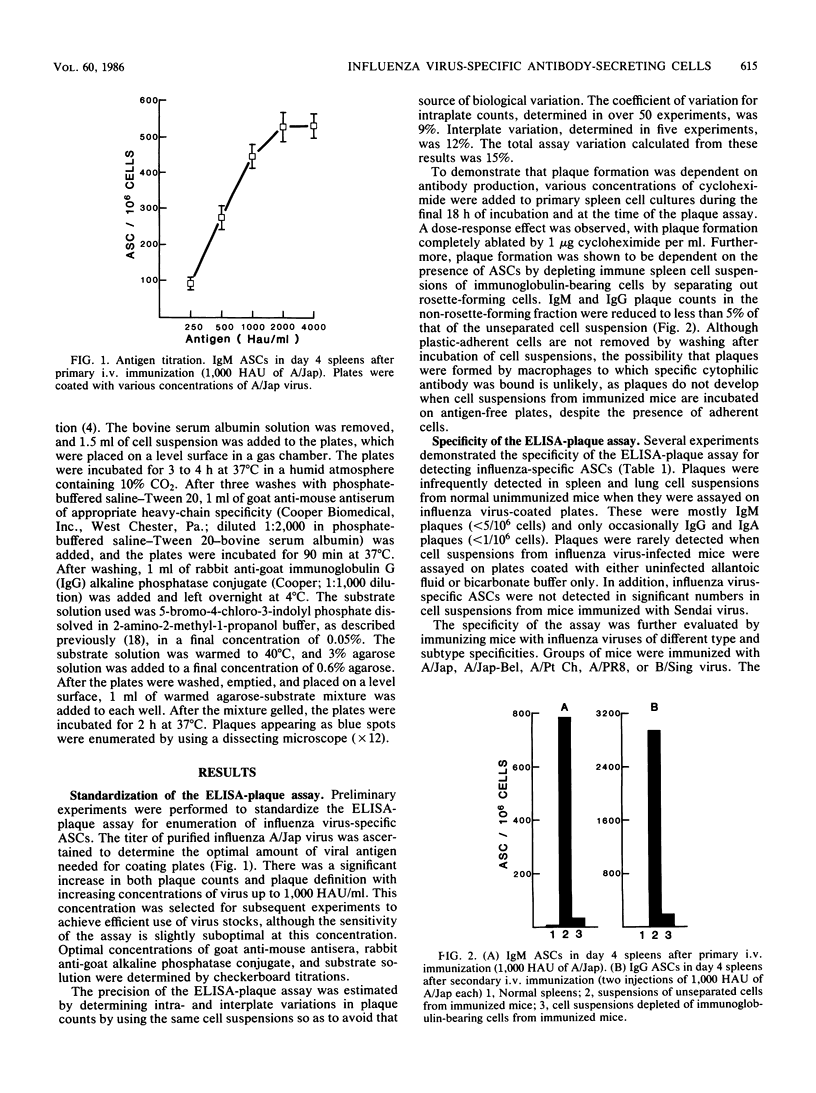

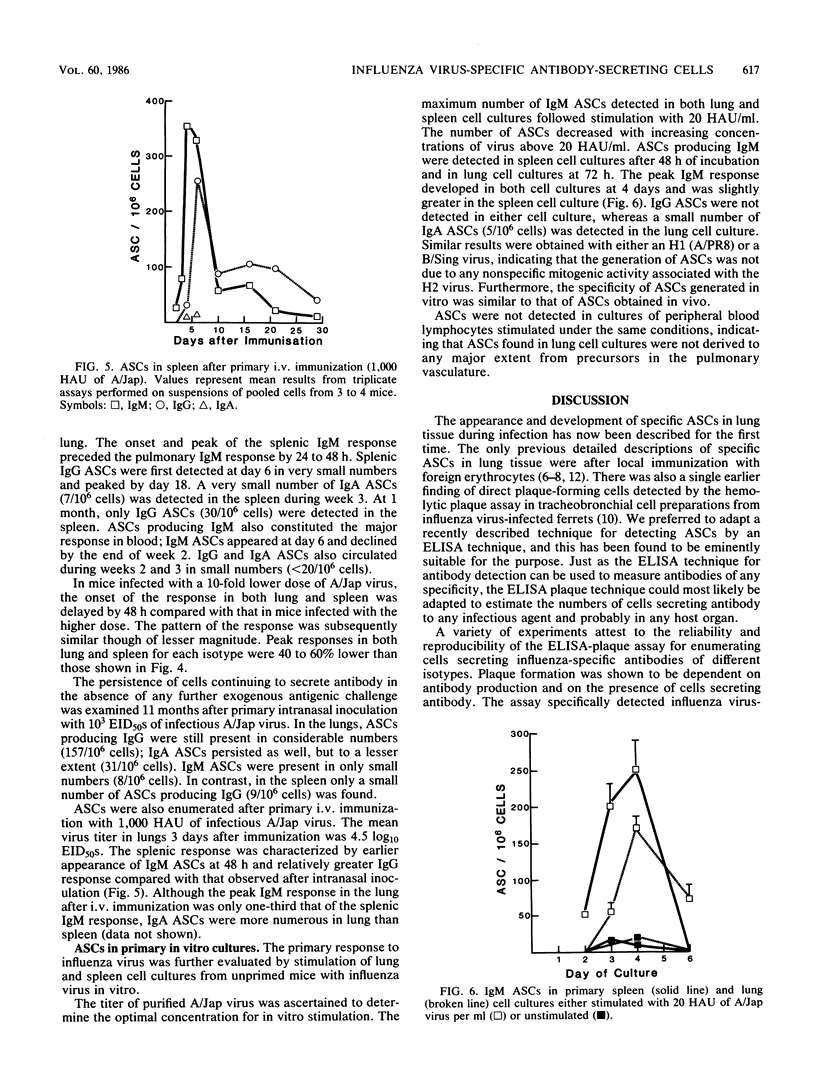
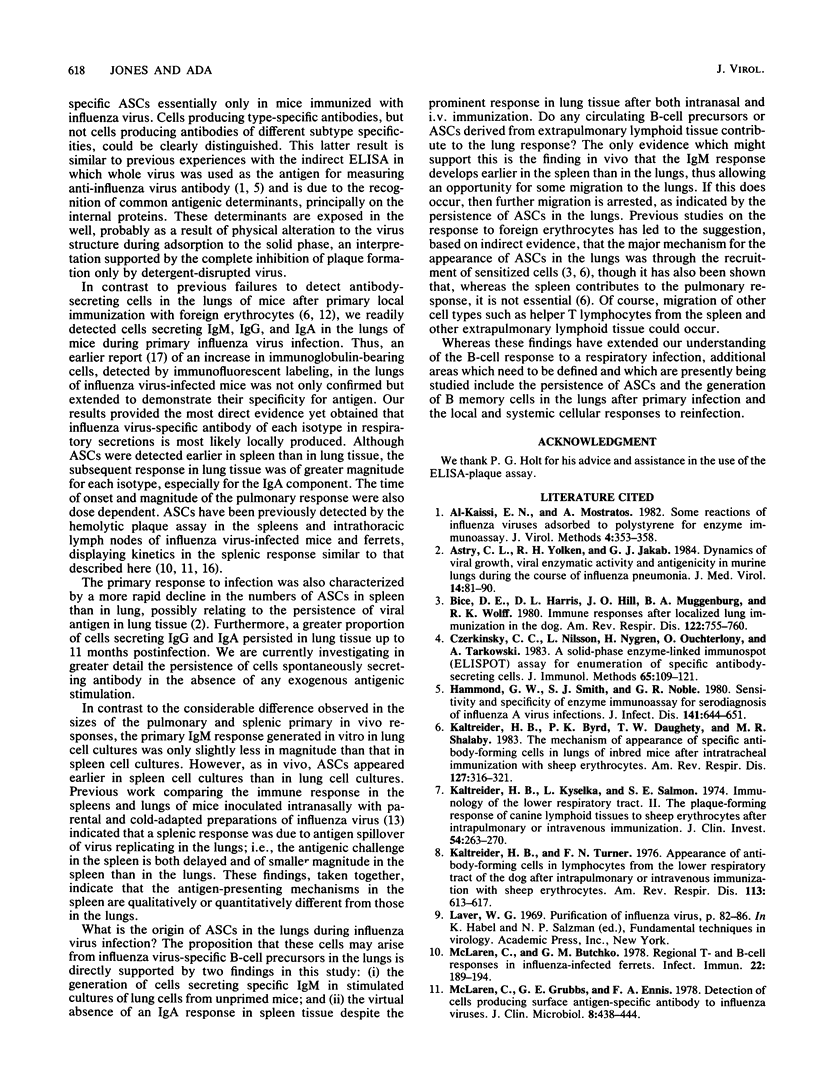
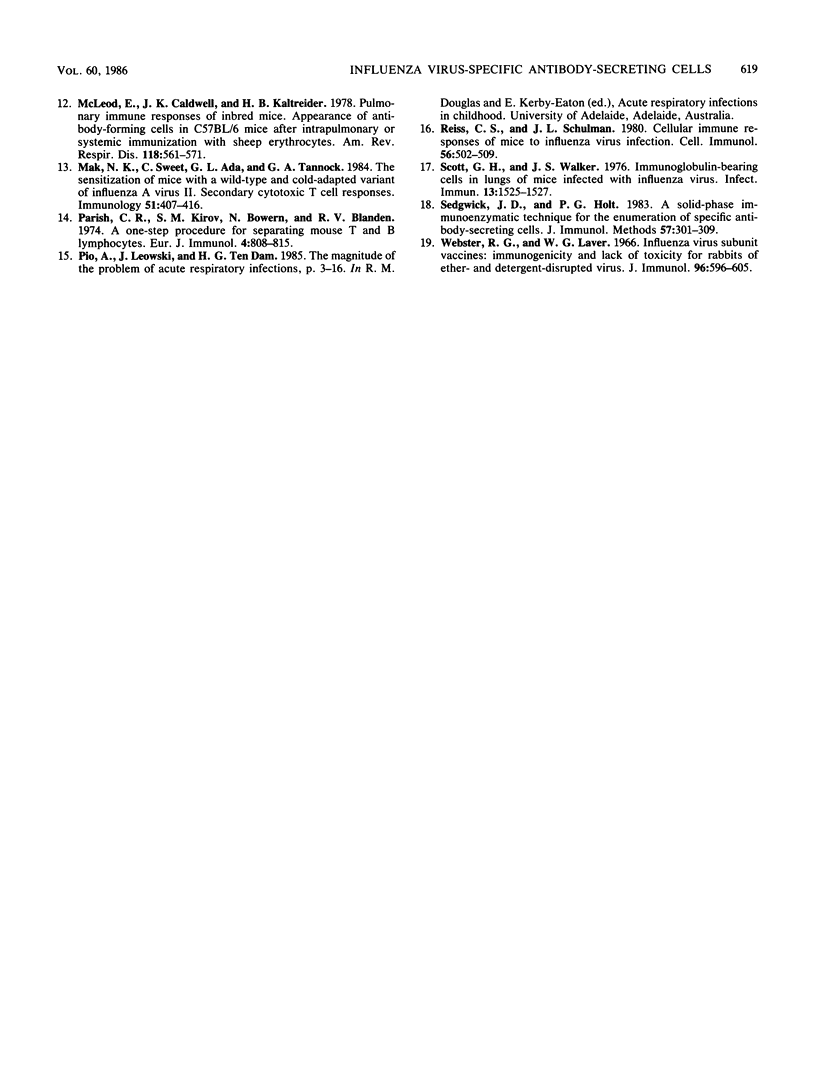
Selected References
These references are in PubMed. This may not be the complete list of references from this article.
- Al-Kaissi E. N., Mostratos A. Some reactions of influenza viruses adsorbed to polystyrene for enzyme immunoassay. J Virol Methods. 1982 Aug;4(6):353–358. doi: 10.1016/0166-0934(82)90060-x. [DOI] [PubMed] [Google Scholar]
- Astry C. L., Yolken R. H., Jakab G. J. Dynamics of viral growth, viral enzymatic activity, and antigenicity in murine lungs during the course of influenza pneumonia. J Med Virol. 1984;14(2):81–90. doi: 10.1002/jmv.1890140202. [DOI] [PubMed] [Google Scholar]
- Bice D. E., Harris D. L., Hill J. O., Muggenburg B. A., Wolff R. K. Immune responses after localized lung immunization in the dog. Am Rev Respir Dis. 1980 Nov;122(5):755–760. doi: 10.1164/arrd.1980.122.5.755. [DOI] [PubMed] [Google Scholar]
- Czerkinsky C. C., Nilsson L. A., Nygren H., Ouchterlony O., Tarkowski A. A solid-phase enzyme-linked immunospot (ELISPOT) assay for enumeration of specific antibody-secreting cells. J Immunol Methods. 1983 Dec 16;65(1-2):109–121. doi: 10.1016/0022-1759(83)90308-3. [DOI] [PubMed] [Google Scholar]
- Hammond G. W., Smith S. J., Noble G. R. Sensitivity and specificity of enzyme immunoassay for serodiagnosis of influenza A virus infections. J Infect Dis. 1980 May;141(5):644–651. doi: 10.1093/infdis/141.5.644. [DOI] [PubMed] [Google Scholar]
- Kaltreider H. B., Byrd P. K., Daughety T. W., Shalaby M. R. The mechanism of appearance of specific antibody-forming cells in lungs of inbred mice after intratracheal immunization with sheep erythrocytes. Am Rev Respir Dis. 1983 Mar;127(3):316–321. doi: 10.1164/arrd.1983.127.3.316. [DOI] [PubMed] [Google Scholar]
- Kaltreider H. B., Kyselka L., Salmon S. E. Immunology of the lower respiratory tract. II. The plaque-forming response of canine lymphoid tissues to sheep erythrocytes after intrapulmonary or intravenous immunization. J Clin Invest. 1974 Aug;54(2):263–270. doi: 10.1172/JCI107761. [DOI] [PMC free article] [PubMed] [Google Scholar]
- Kaltreider H. B., Turner F. N. Appearance of antibody-forming cells in lymphocytes from the lower respiratory tract of the dog after intrapulmonary or intravenous immunization with sheep erythrocytes. Am Rev Respir Dis. 1976 May;113(5):613–617. doi: 10.1164/arrd.1976.113.5.613. [DOI] [PubMed] [Google Scholar]
- Mak N. K., Sweet C., Ada G. L., Tannock G. A. The sensitization of mice with a wild-type and cold-adapted variant of influenza A virus. II. Secondary cytotoxic T cell responses. Immunology. 1984 Feb;51(2):407–416. [PMC free article] [PubMed] [Google Scholar]
- McLaren C., Butchko G. M. Regional T- and B-cell responses in influenza-infected ferrets. Infect Immun. 1978 Oct;22(1):189–194. doi: 10.1128/iai.22.1.189-194.1978. [DOI] [PMC free article] [PubMed] [Google Scholar]
- McLaren C., Grubbs G. E., Ennis F. A. Detection of cells producing surface antigen-specific antibody to influenza viruses. J Clin Microbiol. 1978 Oct;8(4):438–444. doi: 10.1128/jcm.8.4.438-444.1978. [DOI] [PMC free article] [PubMed] [Google Scholar]
- McLeod E., Caldwell J. L., Kaltreider H. B. Pulmonary immune responses of inbred mice. Appearance of antibody-forming cells in C57BL/6 mice after intrapulmonary or systemic immunization with sheep erythrocytes. Am Rev Respir Dis. 1978 Sep;118(3):561–571. doi: 10.1164/arrd.1978.118.3.561. [DOI] [PubMed] [Google Scholar]
- Reiss C. S., Schulman J. L. Cellular immune responses of mice to influenza virus infection. Cell Immunol. 1980 Dec;56(2):502–509. doi: 10.1016/0008-8749(80)90124-0. [DOI] [PubMed] [Google Scholar]
- Scott G. H., Walker J. S. Immunoglobulin-bearing cells in lungs of mice infected with influenza virus. Infect Immun. 1976 May;13(5):1525–1527. doi: 10.1128/iai.13.5.1525-1527.1976. [DOI] [PMC free article] [PubMed] [Google Scholar]
- Sedgwick J. D., Holt P. G. A solid-phase immunoenzymatic technique for the enumeration of specific antibody-secreting cells. J Immunol Methods. 1983 Feb 25;57(1-3):301–309. doi: 10.1016/0022-1759(83)90091-1. [DOI] [PubMed] [Google Scholar]
- Webster R. G., Laver W. G. Influenza virus subunit vaccines: immunogenicity and lack of toxicity for rabbits of ether- and detergent-disrupted virus. J Immunol. 1966 Apr;96(4):596–605. [PubMed] [Google Scholar]


